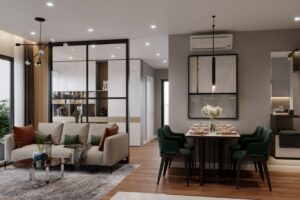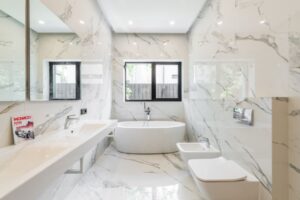Introduction
Ever walked into a room and instantly felt at home or totally turned off? That’s the power of interior design. Why Interior Design Is Interesting Mintpaldecor, we see interior design as far more than stylish couches and on-trend hues—it’s a powerful way to shape how people feel, live, and connect in their spaces. It’s storytelling, psychology, art, and practicality all rolled into one. It’s about shaping spaces that shape us. You don’t just design a room you design how someone feels in that room. That’s fascinating, right? Let’s dive into why this field is endlessly interesting.
The Emotional Connection in Interior Spaces
How Design Affects Mood

Think about it: a bright, airy space with light streaming in and pops of color can lift your spirits. Meanwhile, a dark, cramped room might make you feel closed off. Interior design is emotional engineering. Designers know how to play with color, light, texture, and layout to create moods from calming bedrooms to energizing offices. This emotional power is one of the coolest things about the field.
Personal Stories and Attachment
We get attached to spaces because they’re part of our lives. That sofa isn’t just furniture it’s where you binge-watched your favorite series or cuddled your pet after a long day. Designers work with people to turn spaces into meaningful reflections of their lives, ensuring every nook feels truly their own. Isn’t it amazing how objects and layouts become memory keepers?
Creativity Without Limits
Color Theory and Playfulness
Interior design is a playground for creativity. Want a bold teal kitchen? Go for it. Fancy a monochrome minimalist vibe? Absolutely. Color theory offers a massive palette to evoke emotion, create contrast, or bring harmony. There are no real limits except your imagination and maybe the client’s budget!
Mixing Styles and Eras
You might mix sleek mid-century vibes with laid-back boho touches, or combine raw industrial elements with cozy farmhouse charm. There’s no single “right” way. This freedom to mix styles and eras keeps design fresh and personal. It’s like curating your own art gallery you get to live in.
Blending Art and Science
Function Meets Aesthetics
Design isn’t just making things pretty. It’s solving problems while making them beautiful. Where should the sofa go so people can talk easily? How much light does the workspace need? The best design balances form and function so the space works for its purpose and looks stunning.
Problem-Solving in Design
Ever tried fitting a family of four’s storage into a tiny apartment? Or making a studio feel like it has separate zones? Design challenges force you to think creatively. Solving these puzzles is deeply satisfying, and it’s why designers never get bored.
Reflecting Identity and Personality
Telling Your Story Through Spaces
Your home is your autobiography without words. Designers help clients express who they are from color choices to layout, art, and finishes. You’re not just creating a place to live; you’re telling the world who lives there.
Customization and Uniqueness
Custom furniture, bespoke finishes, personal art interior design celebrates uniqueness. No two projects are the same. That means every day is different for a designer, which keeps things exciting and rewarding.
Cultural Influences in Interior Design
Global Inspirations
Travel has always influenced design. Think Moroccan tiles in a Californian home or Scandinavian minimalism in Japan. Interior design borrows and blends global elements, creating rich, layered spaces that feel connected to the wider world.
Preserving Heritage in Modern Design

At the same time, design can honor heritage. Bringing new life to an older home while making it suit today’s lifestyle? That’s about respecting history while making it practical. There’s something deeply meaningful about preserving the past in our everyday spaces.
Sustainability and Conscious Choices
Eco-Friendly Materials
Design today isn’t just about looking good. Clients want sustainable materials, low-VOC paints, and furniture made to last. Choosing materials like bamboo, salvaged wood, or repurposed fabrics goes beyond fashion it’s a genuine promise to care for the environment. And it’s a fascinating challenge for designers to find solutions that are both green and gorgeous.
Minimalism and Mindfulness
Ever heard “less is more”? Minimalist design isn’t boring—it’s mindful. It’s about reducing clutter, focusing on essentials, and creating calm, purposeful spaces. In a busy world, these spaces feel like a breath of fresh air.
The Psychology of Space Planning
Layouts That Work
Space planning is design’s secret superpower. A badly laid-out room can feel chaotic or cramped, no matter how pretty it is. Designers consider how people move through a space, where they gather, and what they need within reach. A well-planned layout is invisible, but you feel it in how comfortable and easy the space is to use.
Creating Comfort Zones
Ever notice how people gravitate to certain spots in a room? Nooks, reading corners, conversation clusters—all of these are designed intentionally. Interior design is about creating zones that invite people to relax, connect, and feel at home.
Trends vs. Timelessness
How Trends Shape Design
Trends keep things fun. One year it’s terrazzo everything, the next it’s sage green cabinets. Designers stay on top of what’s fresh so spaces don’t feel outdated. But trends are a tool, not the goal.
Building Spaces That Last
Great design balances trends with timeless elements—like natural materials, classic shapes, and quality craftsmanship. That way, a space feels current today but still welcoming in ten years.
Collaboration and Community
Working with Clients
Interior design is deeply personal work. Designers don’t just impose their vision they listen. They learn what clients love, hate, need, and dream of. This collaboration is what makes the final space feel like home.
Learning from Other Designers
Designers also learn from each other. They share resources, inspire one another, and push the field forward. It’s a community where ideas flow, and that collaborative spirit is part of what keeps the field so interesting.
The Business Side of Design
Value of Professional Services
Some people think hiring a designer is just paying for fancy taste. But it’s about saving time, avoiding costly mistakes, and getting access to expertise and resources you might not even know exist. A designer’s work can actually save money in the long run by getting it right the first time.
Interior Design as a Career

And let’s not forget—it’s a career that’s constantly evolving. From staging real estate to designing boutique hotels, there are endless paths to take. That variety keeps designers engaged and constantly learning.
Conclusion
In the end, interior design is interesting because it’s about people. It’s about the way we live, feel, connect, and express ourselves. It combines art, science, emotion, culture, and business in a single, endlessly evolving field. At Why Interior Design Is Interesting Mintpaldecor we think that’s something truly special and we know we’re not alone.
FAQs
What makes interior design special?
Interior design transforms spaces into experiences. It’s not just decor—it’s storytelling, psychology, and problem-solving that improve how we feel and live in a space.
How do designers balance beauty and function?
They consider both equally! Good designers don’t sacrifice usability for looks. They plan layouts, lighting, and storage that work while making sure the space feels beautiful.
Can interior design improve well-being?
Absolutely. Design affects mood, productivity, and even health. Thoughtful lighting, color schemes, and layouts can reduce stress, improve sleep, and boost happiness.
How do cultural elements show up in interiors?
Designers draw inspiration from global styles and traditions. You’ll see this in materials, patterns, furniture shapes, and even philosophies like Feng Shui.
Is sustainable interior design really achievable?
Yes! With growing demand for eco-friendly materials, low-waste practices, and energy-efficient designs, sustainability is not just achievable but essential in modern interiors.
